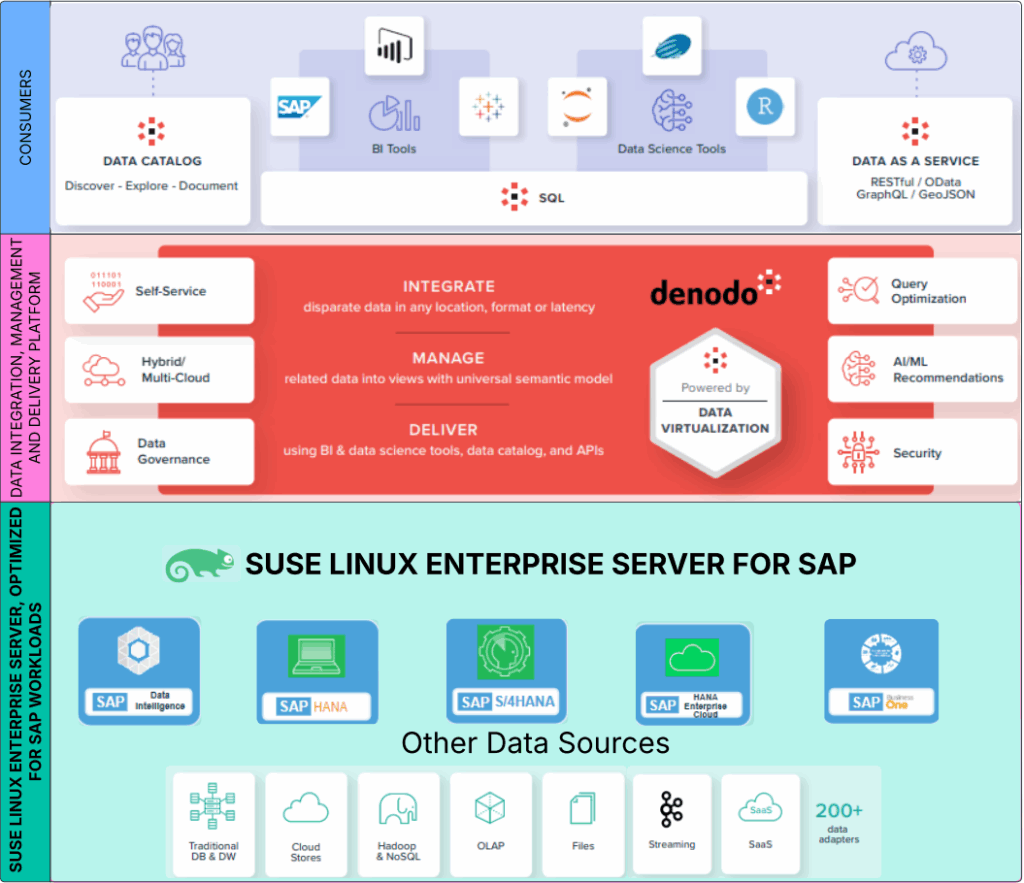
In the first post in this two-post series, we talked about SAP, how many organizations spread their data across SAP, non-SAP, cloud, and on-premises systems, hindering performance and usability, and how SUSE and Denodo create a powerful foundation for SAP, to overcome these challenges and unlock SAP’s full potential. In this post, we are going to dig a little deeper to explain how this works.
Architecture Overview
The two main components are SUSE Linux Enterprise Server for SAP Applications, which provides high availability and optimized system performance, and the Denodo Platform, which delivers real-time data access across SAP and non-SAP systems, without requiring traditional data replication such as extract, transform, and load (ETL) processes (see the diagram below).
The architecture begins, from the bottom up, with SUSE Linux Enterprise Server for SAP Applications. This operating system provides a strong, resilient platform for running SAP workloads. It enables high-availability clustering using Pacemaker and automated SAP HANA system tuning, and it provides data integration across on-premises systems, data centers, and cloud platforms such as Amazon Web Services (AWS), Microsoft Azure, and Google Cloud.
Next comes the Denodo Platform, which enables additional data integration across SAP ECC, S/4HANA, SAP BW, Snowflake, Salesforce, and REST APIs—to establish a logical data layer. This layer provides Power BI, Tableau, or custom applications with access to unified views of the data. The Denodo Platform also enables role-based access control (RBAC) and data lineage tracking, to facilitate data governance, data security, and compliance.
Last but by no means least, we have the data consumers, who can access the data in myriad ways, including – but not limited to – data catalogs, applications, SQL queries, and data-as-a-service implementations.
Additional Data Governance and Security Benefits
We’ve already touched on data governance and security above; additionally, SUSE Linux is certified by Common Criteria EAL 4+ and it also supports SLSA 4 compliance. This supports SAP workloads with secure boot, encrypted file systems, detailed audit logging, and other powerful features. And in addition to providing RBAC support, the Denodo Platform also enables both row-level data masking and OAuth and SAML support. Working in tandem, SUSE Linux and the Denodo Platform deliver seamless data governance and security across highly diverse SAP and non-SAP data sources.
Real-Time Data without the ETL Delays
The Denodo Platform enables the instant querying of live SAP data via optimized connectors as well as JDBC/ODBC connections. It integrates SAP and other sources, such as cloud storage, spreadsheets, and NoSQL systems, without requiring traditional ETL processes, which deliver data in scheduled batches. Selective virtual view caching further reduces latency while minimizing the load on data sources.
Additional Performance Optimization Tips
Organizations can further boost performance by leveraging the Denodo Platform’s selective caching capability for intensive SAP queries, which reduces both latency and round-trip time. Additionally, it is best to configure SUSE’s tuned profiles for SAP HANA, to use memory more efficiently. Also, activating data lineage and tagging in the Denodo Platform improves traceability in audits. Finally, using SUSE High Availability (HA), along with system replication, enables uninterrupted SAP operations during maintenance.
Real-World Case Studies
Here are the stories of three companies that successfully leveraged the SUSE/Denodo solution:
- A global healthcare provider wanted to integrate its SAP system with a number of customer relationship management (CRM) and logistics platforms, for real-time insights. By deploying the Denodo Platform on SUSE Linux for SAP and establishing a logical data layer, the company reduced procurement time by 60% while also enhancing data governance activities.
- A multinational pharmaceutical and cosmetics company had fragmented data stored on both SAP and non-SAP silos, and as a result, the company needed to engage in significant manual reporting. By leveraging the Denodo Platform to provide analytics tools with live data, the company not only accelerated and simplified reporting, but also enabled non-technical users to access data immediately, in a self-service manner.
- A leading aerospace firm was maintaining a complex data landscape spread SAP, Oracle, and a variety of in-house systems. By implementing the Denodo Platform on SUSE Linux, the company enabled real-time executive dashboards without having to rely on ETL processes, accelerating decision-making speed by 70%.
Moving forward with SUSE and Denodo
SUSE and Denodo provide a powerful foundation for SAP, one that is both future-proof and flexibly adaptable to sudden, unexpected changes. Organizations that run SAP ECC, or who are migrating to S/4HANA, or deploying SAP across multi-cloud environments, can benefit from this partnership. The joint solution for SAP offers a unique blend of performance, security, and agility, and enables a rare combination of innovation and stability.
- SUSE and Denodo, Part 2: A Look Inside the Architecture - October 14, 2025
- SUSE and Denodo, Part 2: A Look Inside the Architecture - October 14, 2025

